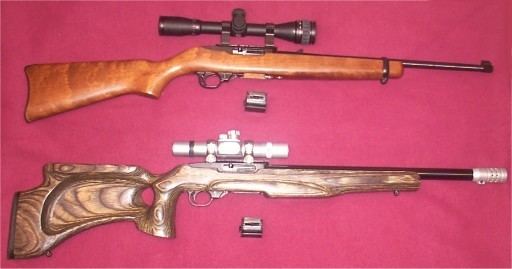Firearm modification is commonly done in order to enhance various aspects of the performance of a firearm. Reasons for these modifications can range from cosmetic to functional, and can be simple operations that the owner can perform, or complex operations requiring the services of a gunsmith.
Common modifications include:
Cosmetic and ergonomic modificationsReplacement or alteration of grips or stocksChanging of sights, such as the adjustable iron sights or a telescopic sightAdding or removing weight to ease carrying, alter balance, or help moderate recoilMetal engraving or custom woodworkCheckering or stippling wood or metalAltering the metal finish, using techniques such as blueing, electroplating, or parkerizingUse of a shorter barrel to reduce size and weight, or a longer barrel to increase velocityCaliber conversionsRechambering or rebarreling for a new caliber, such as conversions made to chamber a wildcat cartridgeUse of a caliber conversion sleeve or other readily removable insert to fire a smaller, less expensive cartrdigeOperating mechanism conversionsMuzzleloading or paper cartridge to metallic cartridge conversions, such as the Allin conversion or Lund conversionConversion from fully automatic or select fire to semiautomatic only or manual operation, or vice versaShort recoil to blowback conversions, used in various .22 Long Rifle conversions, such as the Colt Ace and J. A. Ceiner conversion kits.Conversion from handgun to carbine or rifleAddition of a rifled barrel to a shotgun to allow it to better fire shotgun slugsAccurizingSporterizingSome commonly customized firearms include the Ruger 10/22 carbine, the M1911 pistol, and the AR-15 rifle, all of which have large numbers of aftermarket parts suppliers. Shooting disciplines such as bullseye pistol and benchrest shooting also rely extensively on custom-built and modified firearms to achieve top accuracy.
Care must be taken when modifying firearms, as some operations may convert a legal firearm into an illegal one. An example of this is the restrictions in the US National Firearms Act, which define restricted classes of firearms. Examples of illegal firearms under this act are:
Rifles with overall lengths under 26 inches, or barrels under 16 inches in lengthShotguns with overall lengths under 26 inches, or barrels under 18 inches in lengthMachine gunsA conversion to a fixed cartridge of over .50 caliberThese restrictions vary from location to location; some areas may restrict magazine capacity or require special safety devices such as loaded chamber indicators, integral locking mechanisms, magazine disconnects. Also commonly required are identifying marks such as serial numbers or firearm microstamping components, removal of which may be illegal

